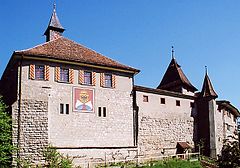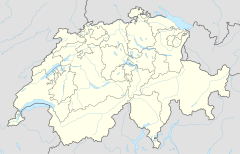Kyburg (castle)
Coordinates: 47°27′31″N 8°44′37″E / 47.4585°N 8.7435°E
| Kyburg | |
|---|---|
 Schloss Kyburg | |
 Location within Canton of Zurich | |
| General information | |
| Classification | Swiss heritage site of national significance |
| Town or city | 8314 Kyburg |
| Country | Switzerland |
| Coordinates | 47°27′30″N 8°44′36″E / 47.458384°N 8.743380°E |
| Construction started | c. 1030 |
| Completed | c. 1530 |
| Website | |
| www.schlosskyburg.ch | |
Kyburg Castle (German: Schloss Kyburg) is a castle in Switzerland, overlooking the Töss river some 3 km south-east of Winterthur, in Kyburg municipality, canton of Zürich. It is a Swiss heritage site of national significance.[1]
History[]
The first fortification at this site was likely built in the second half of the 10th century by the counts of Winterthur. It is first mentioned in 1027 under the name of Chuigeburg ("cows-fort"), which name points to an original use as a refuge castle for livestock. The modern spelling Kyburg first occurs in the 1230s (other spellings of the 11th to 13th century include Chiuburch, Cogiburk, Kuiburc, Chuͦweburg, Chyburc, Qwiburg, Kiburc, Chiburg, Kibor, Kyburc, Kiburg)[2]
The early castle was destroyed in 1028 or 1030 by emperor Conrad II. It was rebuilt and soon became the center of the county of Kyburg which was formed in 1053 as a possession of the counts of Dillingen. In 1079, during the Investiture Controversy, the castle was attacked and partially destroyed by Abbot Ulrich II of St. Gall. By 1096 the counts of Dillingen included count of Kyburg as one of their titles. By 1180, the counts of Kyburg emerged as a cadet line of the Dillingen family.[3] They rose to be the most important noble family in the Swiss plateau beside the Habsburg and the House of Savoy by the 13th century.
After the death of the last count in 1264 Rudolph of Habsburg claimed the inheritance for his family. With one interruption the Imperial Regalia of the Holy Roman Empire were kept in the castle between 1273 and 1322.
The core of the extant castle originates in the 13th century, with the addition of substantial parts in the course of the 13th and 14th centuries. It is among the largest surviving medieval castle complexes in Switzerland, consisting of a bergfried and palas with additional residential and economic buildings and a chapel, all connected by a ring wall enclosing a large courtyard.
In the 1424 the city of Zürich bought the county, and the castle became the seat of the reeve. The dilapidated castle was substantially renovated at this time. The chapel has substantial late Gothic frescoes commissioned by Zürich. Substantial changes to the structure were made under reeve Hans Rudolf Lavater during 1527/8. Further changes were made to the structure in the early modern period.[3]
The castle was plundered by the local populace in 1798, but it was again used as administrative seat from 1803 until 1831, when it was sold by auction to one Franz Heinrich Hirzel of Winterthur who intended to use it as a quarry. To prevent its destruction, the castle was bought by the exiled Polish count Alexander Sobansky (1799–1861) in 1835. Sobansky resided in the castle for the next 30 years. In 1865 the castle was opened as a "Castle and Art Museum" by Matthäus Pfau. Under the next owner, Eduard Bodmer, the museum remained open.[4] In 1917 the Canton of Zurich bought the castle back, since 1999 a society runs it, the Verein Museum Schloss Kyburg.
Events[]
Every summer the Kyburgiade, an international chamber music festival, takes place in the inner courtyard of the castle.[5]
Castle site[]

The castle forms an irregular quadrangle with a single courtyard atop a steep hill above the Töss valley. South of the castle, between the medieval neck ditches, is the French formal garden which was designed in 1700 by Caspar Schwarzenbach. The entrance to the castle is through the outer gate located on the north-east corner. The gate house was rebuilt in 1579-80 and decorated with coats of arms by Christoph and Josias Murer. A zwinger or narrow, defensive passage leads from the outer gate to the inner gate. A walkway goes over the zwinger and connects the palas or great hall with the Willenturm (Willen tower) on the north corner of the castle. The inner gate is protected by the bergfried which was built in 1424 with a roof from 1444.[6]
Views[]

Carton model of the castle

Kyburg in 1740

Panoramic view

General view

Coat of arms
See also[]
- List of castles in Switzerland
References[]
- ^ "Swiss inventory of cultural property of national and regional significance". A-Objects. Federal Office for Cultural Protection (BABS). 1 January 2018. Retrieved 29 October 2019.
- ^ ortsnamen.ch 1027 Chuigeburch, ZUB XIII; 230a; 9. 1028 Eodem Anno Castrum Chiuburch tribus mensibus a Conrado Jmp. obsessum capitur, Liber Heremi. Annales Einsidlenses, 126. 1096 [Graf Adelbert I. von] Cogiburk, Orig ZUB XII; 241c; 16. 1112 Adelbertus comes de Choͧiburk, Z.Ub.I. 143, 258. 1137 [Hartmann II. von] Kuiburc, ZUB XII; 281b; 20. 1152 Hartmanno comite de Chuͦweburg, Orig ZUB XII; 300b; 23. 1155 Dedalricus de Choͧburg, Orig ZUB I; 310; 191. 1173 Arthmannus de Chyburc, Orig ZUB XII; 327a; 26. 1180 et comitem Hartmannum de Qwiburg, Orig ZUB I; 336; 212. 1213 [Graf Ulrich von] Kiburc, Orig ZUB XII; 376a; 39. 1216 V̊lricus comes de Chiburg, Orig Chart Sang III; 1035; 103. 1218 filio comitis Uldrici de Kibor, ZUB XII; 386a; 40. 1223 Warnherus et Hartimagnus comites de Kiburg, Orig ZUB XII; 417a; 46. 1230 de Kiburg, Orig ZUB I; 454; 334. 1233 Hartmanni comitis de Kyburc, Orig ZUB I; 484; 358. 1238 H[artmannus] comes de Kyburg, Orig ZUB II; 511; 13.
- ^ Jump up to: a b Ueli Müller: Kyburg in German, French and Italian in the online Historical Dictionary of Switzerland, 2008.
- ^ "Geschichte : Schloss Kyburg". Schloss Kyburg (in German). Retrieved 29 October 2019.
- ^ "Kyburgiade" (in German). Schwandenstrasse 27, 8802 Kilchberg: Internationales Musikfestival auf Schloss Kyburg. Retrieved 15 Jan 2014.CS1 maint: location (link)
- ^ "Schloss Kyburg" (PDF). api3.geo.admin.ch/rest/services/kgs/MapServer/ch.babs.kulturgueter/7537/extendedHtmlPopup?lang=de. Gesellschaft für Schweizerische Kunstgeschichte. Retrieved 29 October 2019.
External links[]
 Media related to Schloss Kyburg at Wikimedia Commons
Media related to Schloss Kyburg at Wikimedia Commons- Site of the Verein
- Museums in the canton of Zürich
- Castles in the canton of Zürich
- Cultural property of national significance in the canton of Zürich
- Historic house museums in Switzerland
- Illnau-Effretikon








